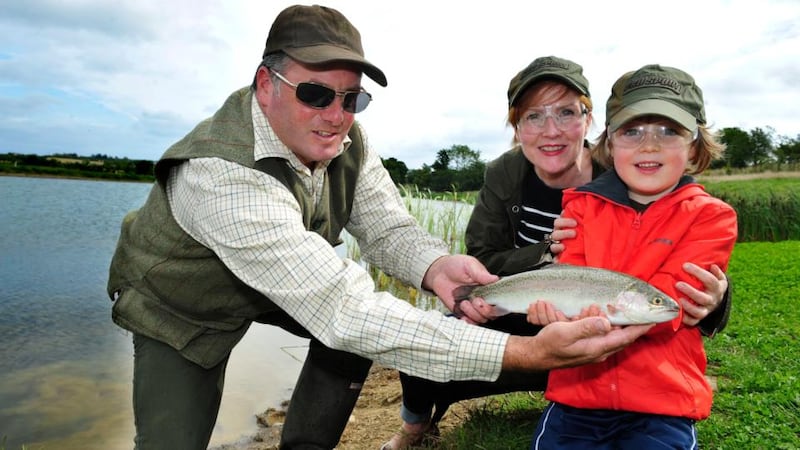For a generation raised on Bear Grylls but without any actual survival skills, going fly-fishing is an authentic way for parent and child to escape the everyday and commune with nature.
“Catching your dinner gives a great sense of your origins,” our taxi driver tells my six-year-old boy, Sonny, as he takes us to Connolly Station to catch the train to Balbriggan to try fly-fishing. Both of us are novices. “It brings out the savage in you,” he adds laughing at Sonny’s reaction – the boy’s eyes are open wide, the size of saucers, as he explains the pastime’s attraction.
“Fishing elevates you from the world and everything else. You can dismiss the world and isolate yourself.”

Leave the phone at home, make like Crocodile Dundee and use the sun as your timekeeper, he counsels. The idea is to aerate Sonny’s young mind and extract him from his favourite pastime: engaging with screens of any size, from the television and his Nintendo 3DS to my smartphone.
The idea of catching your next meal is alien to most city kids. A generation ago children growing up in the country got to experience this first-hand. The lucky ones inherited such skills as part of their everyday education. This craft is being lost.
Courtlough Fishery, just 30 minutes from Dublin city centre, is a great place to rediscover those primitive instincts.
We’re here on what our tutor, Garrett Ruigrok, a former quantity surveyor, calls “a gnarly windy day”, when the rainbow trout retreat into the depths to escape. Before we start we are asked to don baseball caps and Bono-style clear glasses, to protect our eyes from any windswept hooks.
The gentle immersion starts with a casting lesson. “Casting a line is an art form, something that should elicit as much pleasure as the catching,” Garrett explains. “The satisfaction of throwing a good cast, one that lands where you want it to without spooking the fish, is a very specific talent.”
It looks easy but requires the balletic finesse of Rudolf Nureyev. We’re taught turn how to pull the rod back, then execute a co-ordinated wrist and elbow action as the line whips out, cuts through the air and lands silently on the water. Then you start feeding the line in about eight inches at a time. As you pull the line, you hope you will feel the weight of a bite. Then, and only then, is it time to reel in the whining line.
Bucolic setting
Surrounded by expanses of green, with a big sky above, the bucolic setting is taken down only a notch by the distant hum of the M1. Swallows swoop around the water like chorus girls. In the background there is the occasional pop, pop, pop of gunfire, the soundtrack of the gun club that is also on site.
Courtlough Trout Fishery is a managed fishery. The artificial lake is small, about 3½ acres, and is home to 400 or 500 non-native rainbow trout. It is perfect for beginners. With conservation in mind, some 90 per cent of its fisher folk practise a catch-and-release policy, and the fishery insists on barbless hooks. The fish feel like “they’ve been punched, and may suffer a little trout pout, but live to get caught another day,” Garrett explains.
Mother and son are pitted against one another. Sonny gets the first nibble and moves up the bank, reeling in his line, as if he used to do this in a past life. As the slice of silver breaks the water he runs down to the water’s edge to help net the catch. Invited to hold it, he says it feels “slippery and gooey”, but he manages to hold on while expert angler Stuart Marry, who is also lakeside, helps him unhook the 1½lb fish.
The fish have speckled backs, with flashes of the iridescent bellies only visible as you try to gently remove the hook from its mouth.
Call it beginner’s luck, but over the next two hours jammy Sonny catches five, including a double hooker: one line yielding two fish. Mammy loses the only fish she manages to hook.
Afterwards we take a tea break, the tea boiled on a Kelly or Volcano kettle (a product of the Kelly Kettle Company of Newtown Cloghans, Knockmore in Co Mayo. It has the strength of a builder’s brew with a subtle smoky taste.
We are shown the men’s impressive collection of flies made at home to their own designs. A minkie features a long strip of synthetic rabbit fur and a humongous has black and gold plumage and two silver eyes. The confections have to replicate nature very closely.
Another young fan
Sonny is enthralled and asks Ruigrok if he can come back. If you want some one-to-one time with your child, godchild, niece or nephew, this is a gorgeous way to while away a few hours. You get to empty your head of all thoughts. It's just you, the water, the fresh air and hopefully the odd glimpse of rainbow. Are we hooked? Yes, sort-of.
“You have the makings of a fly fisherman,” Ruigrok tells Sonny. A smile as wide as a mile creeps across his face – a face that is already head down, immersed in Subway Surfers on my phone. You can take the boy out of the 21st century – but only for a couple of hours.
Getting there: The 101 bus stops at Knockcross, nearby to Courtlough. Or take the train from Connolly Station to Balbriggan. They can arrange to pick you up from the train. A lesson costs €70. If you want to fish and have your own equipment, a four-hour catch-and- release ticket costs €15. fishing@courtlough.ie,
courtloughoutdoors.ie









